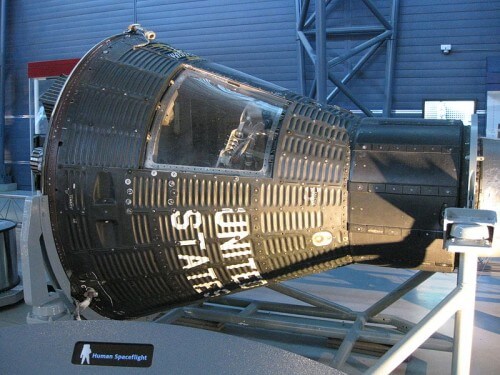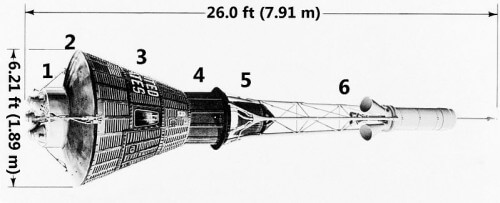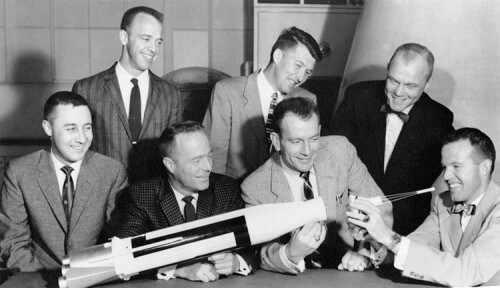Another chapter in the series about the beginning of the space age

As part of the USA's plans to land a man on the moon, the Mercury spacecraft series was the first manned series to be tested in space conditions. The time they spent in space was typical for these flights. These spaceships stayed in space for a short time ranging from a quarter of an hour to 34 hours. These flights are classified into two types. The first two flights were suborbital flights: the spacecraft were launched to a certain height and then returned to Israel. The other four flights were orbital flights: they circled the Earth. These flights were longer. The duration of the flight was gradually extended from flight to flight from 3 laps to 22. The requirements that these spacecraft pilots had to meet were extremely difficult and complicated. Thanks to their fortitude and strong will, these astronauts were able to bring to a successful end the series of flights in Mercury spacecraft as the first step to landing a man on the moon.
As a first step towards the launch of manned Mercury spacecraft, 9 experimental launches of spacecraft and spacecraft models were conducted. Only after the space scientists saw the ability and reliability of these spacecraft to meet the conditions of space, they began to launch humans into space.
The structure of the spaceship
The Mercury spacecraft was designed for one person, for a trip around the Earth. The shape of the spaceship is a huge bell, whose base diameter is 1.8 meters. From its base the spaceship goes and becomes narrow until the bow. The length of the spacecraft is 2.9 meters. The weight of the spacecraft is 1.35 tons. An escape tower is attached to the bow.
- The escape tower

The escape tower is an automatic facility designed to protect the astronauts in times of danger: during the spaceship's stay on the launch pad, during launch and when it moves under the power of its engines during takeoff. A malfunction can be caused by a deviation in the angle of the missile, a loss of thrust, a short circuit, or an excessive rate of rotation.
The tower is operated in 3 possible forms:
- A. automatically
- B. command from the control center
- third. through the astronaut
If a malfunction occurs, an electrical alarm is automatically activated and the missile's thrust stops. The spaceship detached from the missile, the escape tower ignited and by its power the spaceship moved to a height of hundreds of meters. After a second the engine of the escape tower shut down. When the spaceship reaches the required height, a parachute opens that returns the astronaut to earth.
The structure of the cell (see the same note under the title "Escape Tower")
The astronaut lies in a special armchair with his back turned towards the flattened end of the spaceship. To the astronaut's right are control systems for the yaw, pitch and roll. To the left is a manual mechanism for activating the rescue system in case the automatic system does not work.
The control panel is in front of the astronaut and includes gauges for measuring acceleration, ascent or dive rate and fuel supply. In the center of the panel is the control mechanism of the automatic escape system. On the right of the panel are control lights for testing the spacecraft's environmental control system. This system checks pressure and temperature in the spacecraft and the space suit. Extremes on the right, a warning mechanism and a bell, warning lights for emergencies. Below the control lights is the meter for the electrical system and below that the control signals and the communication bell. To the left of the control panel are control devices for the braking rockets, reducing and increasing the pressure. There is also a system of lights to check the operating times of the spacecraft's systems. Green light - everything is going well. Red light - fault. Next to each bulb there is a handle to fix the problem. Below the control panel is a periscope and above it a porthole for viewing the horizon.
- Communication Systems
The spacecraft has a dual communication system, two ultra-frequency (VHF) and high-frequency systems for voice communication, two telemetry channels that integrate into the ultra-high frequency system and a separate emergency system for voice transmissions using an ultra-frequency and high-frequency transceiver.
- Auxiliary systems
The spacecraft has radar spotlights for emergencies, two 16 mm cameras for photographing the astronaut and the control panel, and a 70 mm camera for photographing the horizon. These systems provide information on the state of the scientific equipment, the state of the astronaut and the state of the spacecraft during its flight.

Dispatch
For suborbital flights, Mercury spacecraft were launched with a Redstone missile that developed a thrust of 32,760 tons during takeoff. For orbital flights, they used an Atlas model rocket whose three engines provided a thrust of 154,400 tons. This rocket has 2 stages. In the first stage, 2 engines and in the second stage, one engine.
Before the launch, the astronaut wakes up at 1 am, eats eggs, tea (?!) and orange juice. Two and a half hours before launch, he undergoes final medical tests, puts on the spacesuit, enters the spaceship and checks it for the last time. From now until the end of the flight he maintains close contact with the control center. As the countdown ends, the rocket and spacecraft soar to a high altitude. 2 minutes after launch the first stage engines burn out and shut down. The escape tower also disconnected and with one engine the missile continues to increase its speed. 5 minutes after the launch, the operation of the second stage stops. The spacecraft detached from him, its flattened part being directed forward by tiny jet rockets. The spacecraft orbits the Earth in an elliptical orbit whose distance from the ground is between 256.64-160.4 km and its speed is 29,700 km/h.
landing
Before the spaceship enters the atmosphere, 3 rockets are fired that slow down the speed of the spaceship (the astronaut is then subjected to a force of g12). The flattened end of the spacecraft, equipped with an ablative insulation sheath, is directed towards the ground. At an altitude of 6 km, a parachute with a diameter of 1.8 meters opens, which slows down the speed and stabilizes the spacecraft. At an altitude of 3 km, a parachute with a diameter of 18.9 opens, slowing the speed of the descent to 3 meters per second. Later, a 1.2 meter long plastic pad was deployed under the spacecraft to absorb the shocks of landing on the water. After landing there is a flash of bright light at the top end of the spaceship and the radar transmitters start working. A few minutes later, the spaceship is pulled out of the water by a helicopter and put on an aircraft carrier.
Test flights
The Mercury program began on August 21.8.1959, XNUMX. The space scientists set themselves the goal in their first attempt of launching an unmanned duplicate of the spacecraft with a "Little Joe" rocket from Wallops Island off the coast of Virginia. Half an hour before the launch, the rumble of the missile was suddenly heard and smoke surrounded the launch pad. When the smoke cleared the rocket was still standing, but the launch tower and spacecraft model were gone. The malfunction was caused by the premature ignition of the escape rockets.
On September 9.9.1958, 1000, an Atlas missile was launched to a range of over 900 km. The rocket carried in its nose a cell weighing XNUMX kg with research equipment and air conditioning to find out if there is a possibility of returning humans alive from Earth orbit. The attempt failed.
On October 5.10.1959, 9.9.1958, the missile that was supposed to be launched on September 6, 150 was launched. The rocket whose name was changed to "Little Joe 60" carried a model of the spacecraft in its nose. The purpose of the launch was to test the self-destruct system in case of an emergency. XNUMX seconds after launch, at an altitude of XNUMX km, the missile was destroyed.
On December 4.12.1959, 2, Sugar launched the Little Joe 320 rocket with the monkey "Sam" as part of an experiment designed to test a mechanism for returning humans from space. The monkey was launched from Valfus to an altitude of 39 km. 1 minutes later he landed and was picked up by the destroyer "Buri". The monkey was found alert and in good health, although the landing blow was stronger than expected. The weight of the cell was 8 ton. When the cell was detached from the missile the monkey was subjected to a force of g19 and towards the landing the force reached g3. A measuring device was attached to the monkey's head that can pick up electrical impulses generated by contracting the eye muscles. By measuring these impulses it was possible to determine the degree of dizziness that plagued the monkey. Besides this device, other devices were attached to the monkey's body to measure blood pressure, heart rate, breathing and metabolism. The monkey was weightless for XNUMX minutes. He was trained and used to respond to instruction in the form of a tiny light. When a bulb that emits this light is turned on, the monkey swings a small lever similar to an airplane's steering rod.
Besides the monkey, the cell also contained rat nerve cells, test tubes of bacterial cultures and insect eggs. The researchers wanted to examine the effect of acceleration, weightlessness and the effect of radiation on these animals.
The launch of Little Joe 5 was postponed due to technical problems on one day from 7.11.1960 to 8.11. While the accelerator was operating, the escape rocket and the combination rocket of the escape tower were accidentally ignited, the parts stuck together and with strong acceleration crashed into the ocean 21 km from the coast.
Mercury 1
On November 12.11.1960, 1, the first Mercury spacecraft was launched, Mercury 10. The spacecraft was launched with a Redstone rocket. Launch failed. At the end of the count, the engine began to operate with the characteristic thunder. The missile rose to a height of XNUMX cm and landed on the launch pad. At that moment the escape tower detached from the spaceship and rose into the air. A few seconds later the parachute opened. Slowly the parachute fluttered as it moved towards the ground and following it the spare parachute that was in the opening on the side of the spaceship opened.
MR-1A
On 19.12.1960/1/1, a Redstone model missile was launched with a model of the Mercury spacecraft called (MR-1A Mercury Redstone 210A) weighing 15 ton. The rocket soared to a height of 45 km. XNUMX minutes and XNUMX seconds later the cell landed near the Bahamas and was brought aboard an aircraft carrier.
Mercury 2
On January 31.1.1961, 2, the Mercury XNUMX spacecraft was launched with a chimpanzee named "Ram" for a suborbital flight. The purpose of the flight was to test whether it is possible to return a spaceship even in the event that the astronauts lose consciousness. The monkey was tied to a couch made of fiberglass. Electrodes were attached to the monkey's body to check heart rate, blood pressure, breathing and body temperature. The monkey was photographed by cameras. The radio signals received from the spacecraft proved that the monkey fulfilled the duties assigned to him. The monkey's job was to pull two levers, on the right lever when a white light was on and on the left lever when a blue light was on.
The speed of the spacecraft was 335 meters per second greater than planned. The monkey was in a state of weightlessness for 6.6 minutes in place 49 and the force acting on it was g3 greater than planned. The flight lasted 16 minutes. Despite the higher than usual figures, the monkey returned to Israel safe and sound. The spacecraft landed in the Caribbean Sea 200 km from the planned landing site.
Mercury 3
On April 25.4.1961, 3, Mercury XNUMX was launched by an Atlas missile with a mannequin in it. This doll was built so that it consumed oxygen like a human and released adequate amounts of carbon dioxide and heat. This is a facility designed to test the cell's survival system.
The purpose of the flight was to perform a long-range suborbital flight. A few days before the launch, the mission was changed to a full orbital flight with the distance from the ground being 160 km. The spacecraft was supposed to land in the Atlantic Ocean.
A flaw in the rocket's inertial system did not give it the necessary inclination to put the spacecraft into the correct orbit. A huge jet of light was seen in the missile and an explosion was heard. The safety officer had to activate the self-destruct system about 40 minutes after launch.
"A review of the astronauts and their missions on Mercury"

Alan Shepherd
On May 5.5.1961, 200, the USA sent Alan Shepard on a suborbital flight. Shepard was launched in the Mercury spacecraft by a Redstone rocket. After Shepard reached an altitude of 15 km, the spacecraft was detached from the rocket and landed in the sea. The duration of the flight is 22 minutes and 1998 seconds. Shepard died in XNUMX. (LAccording to the definitions of the Federation for Astronautics, Shepard should have been considered the first astronaut because Yuri Gagarin fell from his capsule and did not land inside it on the ground)
Virgil Grissom
Virgil Grissom, like Alan Shepherd, launched into suborbital flight. The launch was made on 21.7.1961/240/15 using a Redstone missile. When the spacecraft was at an altitude of 37 km, it returned to Israel and landed. The flight lasted XNUMX minutes and XNUMX minutes. During the landing several problems arose which almost caused Grissom's death. The moment the spaceship reached the water, its door opened due to a short circuit. The door should have been opened later. Grissom, who was also prepared for such a case, did not lose his temper and jumped into the water. Here his condition worsened even more. One of the buttons on the space suit opened and the suit began to fill with water. Grissom almost drowned and he was saved at the last second. The spaceship itself with all its expensive equipment sank in the water. Grissom was killed in 1967 in the explosion of the Apollo 1 spacecraft on the launch pad
John Glenn
After 10 postponements, John Glenn was launched on 20.2.1962 for a 5-hour journey in which he circled the Earth 3 times in a spacecraft called 7Friendship. The spacecraft was launched by an Atlas rocket and weighed 1935 kg. It circled the Earth in an orbit whose distance from the ground ranges from 262-161 km and at a speed of over 28,000 km/h. During the flight, Glenn saw "luminous particles" that puzzled the scientists.
On the third lap there was panic among the ground crew when the tracking station in Australia picked up telemetry signals indicating that the front heat shield had come loose. There was concern that the shield might be released completely at the beginning of the entry into the atmosphere. This means that the spacecraft could burn up with a squadron. And yet something could be done. The braking rockets were attached by straps attached to the spacecraft as usual, the astronaut had to release these rockets after they finished their job. Now Glenn was told not to release the rockets when the intention was to prevent the release of the shield. The rockets worked fine (Glenn later said the thrust was so strong he felt as if they were about to be pushed back to Hawaii). During the entry into the atmosphere that occurred across the USA, he stabilized the spacecraft as best he could. Glenn saw fiery fragments of the containment rocket casing fly past the spacecraft's window. All signs indicated that the heat shield was connected correctly and the false warning was given due to a fault in the warning system. After Glenn was brought aboard the aircraft carrier that lifted him out of the ocean, technicians had difficulty opening the door. Glenn had to blow up the door with a special explosive device. (John Glenn is still alive)
Scott Carpenter
On May 24.5.1962, 7, astronaut Scott Carpenter was launched into Earth orbit to perform a series of experiments that John Glenn had begun. This spaceship, which was called Aurora 1925, weighed 3 kg, circled the earth 4 times for 56 hours and 161 minutes in an orbit that is 269-XNUMX km from the ground.
For some reason, Karftner used a wasteful flight method already in the first lap. This method consumes more fuel than necessary. The fuel supply was being wasted at an alarming rate and the experiments were delayed. After the fuel supply dropped to 45%, Carpenter was instructed to switch to manual steering. When it was preparing to land, the automatic device designed to tilt the spacecraft at the right angle for entering the atmosphere malfunctioned. Karftner tried to fix this by combining manual steering and "fly by wire" - semi-automatic flight. 5 seconds later he activated the braking rockets manually with 15% of the fuel remaining in the automatic tank. Due to the delay in the activation of the braking rockets and the incorrect angle of entry into the atmosphere, the spacecraft landed at a distance of 400 km from the planned landing site. 40 minutes after landing, Carpenter was brought to safety with his precious cargo. (Still alive according to Wikipedia)
Walter Shira
Walter Shira was launched into Earth orbit on October 3.10.1962, 7 in a Mercury spacecraft named Sigma 6. He circled the Earth 9 times in a time of 13 hours and 283 minutes, in an orbit that is 161-1962 km from the ground. The weight of the spaceship is 5 kg. An automatic ignition mechanism was installed in the launch vehicle. Thanks to this, those 10 seconds were omitted between the activation of the lighter and the emission of the flame and the plumes of smoke from the missile. XNUMX seconds after liftoff the rocket began to roll (rotation around its longitudinal axis) and for a few seconds it seemed that it was necessary to activate the fixed escape tower at the top of the spacecraft. The rocket stabilized and the entry into the national orbit was a complete success.
Shira received instructions to save as much fuel as possible and to let the spaceship glide freely for about a third of its flight so that the fuel saved would be useful to him when he applied the brakes before entering the atmosphere. Contact with the ground was stopped for a while in order to save electrical energy. When he finished the first lap, the degree of heat in his body rose above the desired level. In the second lap he managed to regulate the heat in his suit. It was the only malfunction of the entire flight. During his flight, Shira noticed white particles, a kind of "fireflies" similar to those that John Glenn saw during his flight. Shira had two cameras attached, one for photographing the clouds in black and white and the other for color photographs of the earth's reliefs.
Several months before the launch, in July, the US detonated a hydrogen bomb at high altitude, resulting in the creation of a new radiation belt around the Earth. If the spacecraft had entered this strip, Shira would have been hit and died. (Walter Shira died in 2007)
Gordon Cooper
The last flight in the Mercury program was on May 15.5.1963, 7. Gordon Cooper manned a spacecraft named 14.5Faith. According to the plan, the launch date was supposed to be on 20. Two malfunctions led to the postponement of the launch on the day, one in the diesel engine of one of the facilities at Kif Kennedy and the other in the radar system on the island of Bermuda. In the first hours of the launch, Cooper encountered a number of minor difficulties such as the thermostat in his space suit. This malfunction disturbed his rest and he was unable to sleep as planned. This glitch was later fixed. In the last three laps, the tension increased among those people involved in the flight. On the 15th lap, a malfunction occurred in the automatic control mechanism of the spacecraft. A green light turns on unexpectedly. This light only turns on when the spacecraft enters the atmosphere at the end of its flight. The spacecraft continued its flight without incident and it turned out that the entire system related to this light went wrong. During the next lap a short occurred and the automatic stabilization system was left without electrical supply. Cooper had to manually activate the braking rockets meant to bring him back to Earth, instead of the spacecraft being powered by a radio signal from Earth. In the third lap, Cooper released a 22 cm diameter bullet equipped with a strong reflector. The ball entered a different lane. On the fourth lap Cooper noticed the flashing light. The spacecraft had television cameras that transmitted images from the spacecraft mirror, but they were not clear. Cooper circled the Earth 34 times in 20 hours and 267 minutes. In a route whose distance from the ground is 161-1814 km. The weight of the spaceship is XNUMX kg. (Cooper died in 2004)
